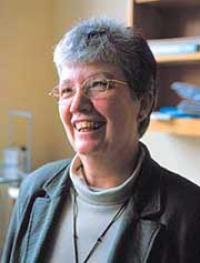 |
Biology Department NSF Distinguished Teaching Scholar award in 2003 Fields: Cell Biology |
|
• Website » |
Email: mledbett@holycross.edu
|
Courses
- Cell Biology
- Immunology
- General Biology 1
- Topics in Biology: Genetic Engineering
- Montserrat: The Biology of Health and Disease
Research
Through my research I try to understand the biochemical mechanisms regulating growth and gene expression in mammalian cells. The principal techniques used are cell culture, isotopic tracer studies, spectrophotometry, fluorimetry, microscopy and molecular biology. Substantial computer work is done to analyze microscopic images and to mine genomic and microarray data bases. Usually I work with established cell lines and strains, both normal and tumorigenic, that have been in continuous culture for extended periods. If necessary, though, I have the capability of establishing new cell strains directly from tissue specimens or doing short-term experiments in organ culture.
My current work involves a phenomenon whose function is not completely understood: cell communication through gap junctions. Briefly, cells, both in tissues and in culture, can form junctions with other cells, and materials can then pass among the cytoplasms of all cells communicating in this way. A physiological role for cell communication is suggested for cells whose growth is regulated. Tumor cells or actively dividing embryonic cells frequently show altered communication. Thus one hypothesis is that cell communication is necessary for growth control. Using several kinds of assays for cell communication in cultured cells, I measure the effects of various agents known to promote or suppress growth. Where possible I also attempt to discover the mechanism underlying the activity of those agents that affect cell communication. The correlations obtained carry implications for the normal function of cell communication.
Recent work has revealed effects on cell communication of agents that influence ion transport across the cell membrane. Steroid hormones also influence communication among cultured kidney cells. These observations are the basis for current studies.
We interfere with ion transport by treating cells with ouabain, a drug that blocks the membrane sodium pump. We then monitor the behavior of the treated cells.:
Their ability to share small fluorescent molecules (a measure of their cell-to-cell communication);
Their ability to form gap junctions between adjoining cells
The distribution of the gap junction constituent, connexin-43, in various cellular compartments, studied by immunohistochemistry;
The amount of connexin-43 in cell extracts, detected by electrophoresis and immunoblotting;
The level of expression of the genes for connexin-43 and other proteins, monitored by extraction of RNA and analysis by polymerase chain reaction, Northern blotting, and microarray analysis.
My students and I use these methods to see how agents that influence cell communication modify expression of gap junction genes.
After retiring from teaching, I served for two years as a Program Director in the Division of Undergraduate Education at the National Science Foundation. There I learned about administration of government programs to support innovation in STEM education and teacher preparation. That work and ongoing interest in educational transformation informs my work on the editorial board of CBE: Life Sciences Education and in educational consulting.
Publications -- * denotes student co-authors
Ledbetter, M.L.S. and Gatto, C. L.* 2003. Concentrations of ouabain that prevent intercellular communication do not affect free calcium in cultured fibroblasts. Cell Biochemistry and Function 21:363-370
Ledbetter, M.L.S. and Lippert, M. J. 2002. Glucose transport in cultured animal cells: An exercise for the undergraduate cell biology laboratory. Cell Biology Education 1:76-86.
Ledbetter, M.L.S. and S.L. Valentine*. 1997. Furosemide protection of Balb/c 3T3 cells from reduction of connexin43 levels induced by ouabain. Mol. Biol. Cell 8:93a.
Ledbetter, M.L.S., C. Clark*, A. Comi*, C. Leo*, R. Lue*, R. Morasco*, and A. Tremblay*. 1995. Ouabain inhibition of cell communication may be associated with mobilization of cell calcium. Prog. Cell Res. 4:367-370.Berthoud, V.M., M.L.S. Ledbetter, E.L. Hertzberg, and J.C. Saez. 1992. "Regulation of gap junctions by cell contact and phosphorylation in MDCK cells", in Proceedings of the Fourth International Conference on Gap Junctions, ed. J.E. Hall.
Berthoud, V.M., M.L.S. Ledbetter, E.L. Hertzberg, and J.C. Saez. 1992. Connexin 43 in MDCK cells: regulation by a tumor promoting phorbol ester and Ca2+. Eur. J. Cell Biol.
Ledbetter, M.L.S., P.L. Medrek*, and B.M. Spinney*. 1991. Potassium transfer assay for cell communication: effects of phorbol esters, retinoic acid, and furosemide. Amer. J. Physiol. 261:C1115-C1122.
Ledbetter, M.L.S., G.J. Young*, and E. Wright. 1986. Cooperation between epithelial cells demonstrated by potassium transfer. Amer. J. Physiol: Cell Physiol. 250:C306-C313.Ledbetter, M.L.S., and M. Lubin. 1980. Interference of ouabain in cell-to-cell coupling. Exp. Cell Res. 129:73-81.
Ledbetter, M.L.S., and M. Lubin. 1979. Transfer of potassium: A new measure of cell-cell coupling. J. Cell Biol. 80:150-165.

